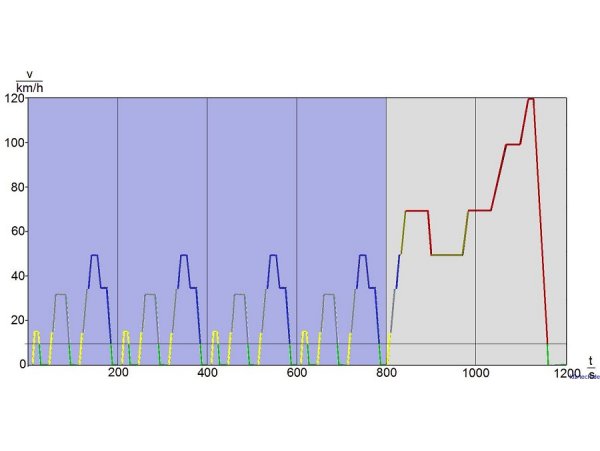
|
What are consumption-figures worth?
Fortunately, there are hardly any car buyers left, who believe anything that the car-manufacturers would like them to believe. We at cartecc.com, publish the 'standard consumption' given by the manufacturers only
in very exceptional cases. If necessary, one could determine the consumption from the CO2-emission values. Indeed, why would one want to do this?
Particularly prominent are the values given for PlugIn-Hybrid cars. They are given the energy content of their battery as a gift. This means, as soon as you have a battery on board, which has a range of 100 kms, you'll
have one of the first cars with 0 g/km CO2
| 250 km/h with 0 g/km CO2!!! |
Responsible for this, is the New European Driving Cycle (see figure below). In this case 'New' points to the modification from 1996, the test track, to be driven at a max. of 50 km/h and
having 12 intermediate stops, is nevertheless, still pretty urban. Towards the end, the speed is increased for a short time to 70 km/h and then ends with a breathtaking 120 km/h.

The preparation for this test, done exclusively on the test-bench, is actually very sensible because when coasting down from higher speeds, the resistances which arise are measured. These values are then taken
into consideration during the actual test-run. Indeed, what use is this, if for a short period at 120 km/h, the recommended maximum speed (130 km/h) on motorways is not even required?
The numerous intermediate stops also explain why the manufacturers so highly estimate the value of the start-stop feature. It is useful for them during the testing, is however, no use to the car drivers in practice. One
can't help thinking, that the measurement is aimed at the result to be obtained, and not the results of the measured values.
The FAZ (Frankfurter General Newspaper) took the trouble, in their edition from 18.06.2013, to compare the values given by the manufacturers with the values attained in real-life, thereby deviations of up to 75 percent
were ascertained. In the case of the Volvo V60 Plug-in hybrids, due to the unnatural bonus, there was even a deviation of more than 260 percent! The threat of a penalty payment did affect the catalogue values, but did
not have the same measure of affect on the real-life figures.
It is said, that there's land in sight. Apparently there is a new World Light Test Procedure. The introduction is actually planned for 2017, indeed, the Association of Autobobile
Manufacturers (VdA) sees this differently. The lobby, is apparently still trying to polish it up, a far as the date and the introduction are concerned.
This is of course, difficult for the manufacturers to cope with, if the agreed CO2-emission value of 95 g/km for 2020 is to be adhered to and the testing method is also made stricter. Whereby, on the side,
a number of positive aspects can be seen: Research in this field and the sale of electric powered cars etc.
Now, what does this information mean to you, as a consumer?
1. Don't trust the NEDC-test. Least of all for cars with a battery.
2. Trust the future WLTP-test only up to a point. It could be further watered down.
3. At most, compare the achieved test results of various
vehicles.
4. Before you buy a car, read all the practical, independent road-tests that you can. 07/13
|
|